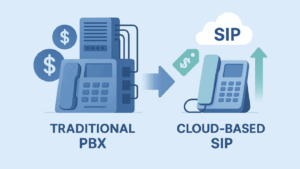
SIP Technology: How It Changes the Game for Today’s Businesses
Session Initiation Protocol (SIP) technology, is integral to many businesses’ unified communication strategy. Companies are changing to facilitate a worldwide, connected environment, remote office dynamics, and digital transformation for collaboration and SIP communication. With a value of over 11 billion in 2021, between 2022 and 2031, the SIP trunking service market is expected to grow by over 14% annually. Organizations are moving to unified communications and Voice Over Internet Protocol (VoIP) solutions powered by SIP for enhanced scalability and reduced costs. SIP is an ideal solution to manage and consolidate communications in the cloud.
If you are investing in SIP trunking for your company or client, this blog will help you understand the advantages of the communication solution. We will explore SIP technology, how it works, and the benefits an organization can take advantage of when it moves to a cloud-based communication solution.
What Is Session Initiation Protocol?
SIP stands for Session Initiation Protocol, a game-changer for businesses looking to scale their communications quickly, efficiently, and affordably. While SIP and VoIP are sometimes used interchangeably as both transmit communication data over the internet, the two technologies are distinct. VoIP is the ability to make voice calls and send messages over internet networks and is made possible by SIP technology.
SIP messages initiate, maintain, and terminate communication sessions, making them essential for reliable and efficient interactions in modern business environments. SIP initiates and terminates information transfer between two or more communication devices and is the preferred method for VoIP and in-app communication. It can reliably connect devices over the internet to share voice, video, instant messages, files, and other multimedia communication sessions. SIP technology also provides trunking, allowing an organization to route traffic from multiple devices using a single trunk. SIP trunking is limited only by the number of channels—that can be provisioned on demand—rather than the number of costly physical lines to a Public Switched Telephone Network (PSTN), allowing for improved scalability and cost-efficient communication and collaboration.
Definition and Brief History of SIP
Session Initiation Protocol (SIP) is a cornerstone of modern communication, enabling real-time multimedia interactions over the internet. Developed in the 1990s by the Internet Engineering Task Force (IETF), SIP was standardized in 1999 under RFC 3261. This text-based protocol, modeled after HTTP’s request and response model, operates on the application layer, making it both flexible and powerful. SIP is widely used in VoIP platforms to initiate, manage, and terminate call sessions, providing enhanced functionality that supports a variety of communication environments.
Role of SIP in Communication
SIP plays a pivotal role in streamlining communication by facilitating real-time multimedia exchanges over the internet. For small- to medium-sized businesses, SIP offers a structured and cost-effective approach to managing communication systems. It supports VoIP telephony, video conferencing, and instant messaging, making it a versatile tool for modern business needs. Additionally, SIP trunking leverages the internet to send voice and other Unified Communications services, further simplifying and reducing the costs associated with traditional communication methods.
Phone Lines Before SIP Technology
Before SIP technology, unified communications, VoIP, and internet-connected mobile devices, organizations relied on landline phones to communicate with partners and customers outside the business. Employees made calls over a Primary Rate Interface (PRI), a technology where a company purchased a physical copper line to connect to the telephone company’s network using a PSTN.
A challenge of PRI communication is the cost of each line and their limited support of only 23 simultaneous callers and one data channel per line. A private branch exchange (PBX) allowed the organization to make internal phone calls. It could also route external calls and include beneficial technologies like call forwarding, voicemail, and transferring calls.
SIP can work alongside an existing PBX or replace it with a cloud-based virtual PBX. Modern SIP technology allows for all of the features of the PBX with the scalability, security, reliability, and cost of a cloud-based solution.
SIP relies on concepts similar to PRI but runs the calls over the internet using virtual channels rather than physical lines to a PSTN. With the phone company out of the equation, you no longer need to use a phone network’s PRI. SIP trunks have virtually replaced PRI as the preferred communication routing method for businesses worldwide.
The primary role of SIP is to start and end a data transmission, including voice calls, instant messages, or video chat. A communications platform provides access to the SIP trunk through an account. Users access the trunk through a PBX, IP phone, mobile device, or software phone. When a user places a call from their device, SIP initiates the call with a server. The communication data is sent through the trunk through the organization’s communication network or a PSTN, routing the communication data to its destination. Real-time transport protocol (RTP) is crucial in SIP communications for managing the timely delivery of media data, such as audio and video, during VoIP calls. When either user ends the call, SIP terminates the connection on the network.
Related: SIP Trunk: How to Reduce Costs and Maximize Efficiency
The Benefits of SIP
Now that you know how SIP works, how can it benefit your business or client? Here are some of the ways SIP technology can improve your telecommunications:
-
Reduced Costs: Because you can buy the exact number of SIP channels you need and eliminate expensive PRI contracts, your client or organization will likely have lower communication costs with SIP.
-
Increased Flexibility: SIP channels can quickly be provisioned online from a web console. You can add or reduce channels at any time. There’s no need to schedule an installation or interrupt business. The cloud provides near-unlimited scalability.
-
Mobility: Businesses that plan to change locations or want to offer remote work opportunities to their employees benefit from SIP’s enhanced mobility. Following the COVID-19 pandemic, remote work became a necessity for many organizations. A study from HR Dive found that nearly 60% of organizations were positively impacted by offering remote work opportunities. SIP can allow your client or company to provide remote office dynamics without stress.
-
Carrier-Grade Reliability: Reputable SIP providers offer carrier-grade reliability and 24/7 uptime to ensure users can always make calls, regardless of business hours.
-
Transport Layer Security: Utilizing Transport Layer Security (TLS) in SIP communications ensures the encryption of media content and signaling messages, protecting against eavesdropping and unauthorized access.
-
Bring-Your-Own-Devices: If your client or organization invested in a PBX, there is no need to worry about not being able to use your existing technology. When your client or company partners with the right SIP platform, it can use existing PBX and devices on the SIP trunk. Your client or company can also use their existing carrier.
-
Features and Enhanced Functionality: SIP platforms offer a range of features to enhance communication and collaboration capabilities, including e911, fault-tolerance DID routing, and a powerful yet simple web-based control panel.
Related: The Benefits of SIP Trunking for Your Business: Why You Need It Now
SIP Technology and Architecture
At the heart of SIP trunking and SIP phones lies SIP technology, a set of online standards that enable real-time voice, video, and other media communications. SIP operates over any high-speed internet connection and serves as the foundation for Voice over Internet Protocol (VoIP). It is compatible with both IPv4 and IPv6 and can utilize either TCP or UDP, ensuring robust and flexible communication capabilities across various network environments.
User Devices, Network Connectivity, Proxy Servers, and Registrar Servers
User devices, such as IP phones, mobile devices, and software phones, act as endpoints that send requests and communicate with other users’ software. For SIP software to function effectively, reliable network connectivity is essential. Proxy servers play a crucial role by receiving requests from user endpoints and forwarding them to the recipient’s server or device. Registrar servers handle REGISTER requests from user devices, sharing this information with other users involved in the media session, thus ensuring seamless communication.
SIP in Voice Calls and Instant Messaging
SIP is integral to the functionality of voice calls and instant messaging. It sets up and terminates voice or video calls, defining the messages exchanged between endpoints. In VoIP and VoLTE environments, SIP enables features such as call forwarding and chat notifications, enhancing the user experience. Additionally, SIP supports instant messaging by providing real-time text transmission over the internet, ensuring efficient and immediate communication.
By understanding these aspects of SIP, businesses can better appreciate the technology’s capabilities and the advantages it offers in modern communication landscapes.
Get Started With SIP From a Leading Communications Platform
Organizations rely on scalable, flexible, and mobile solutions as offices can span several time zones, and on-demand communication and collaboration are vital. A SIP investment plan provides a fast, affordable, and versatile solution for organizations requiring voice, video, and chat. A reputable platform can ensure your organization or client gets the optimal value from a SIP solution. Are you ready to enhance your client or organization’s communications with a SIP solution from SIP.US? Get started today.



